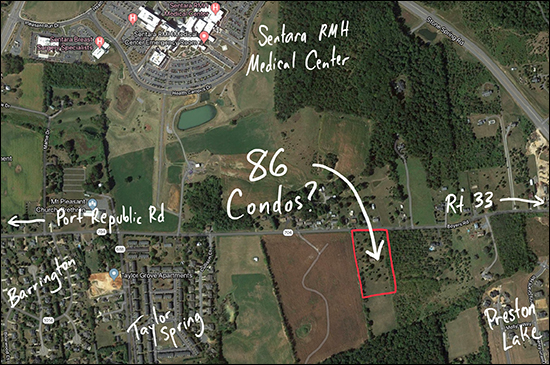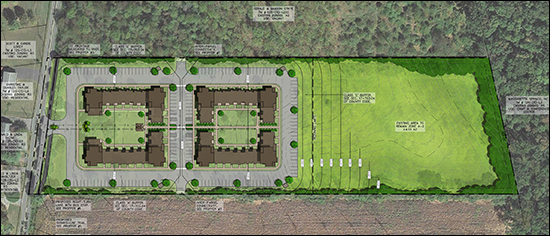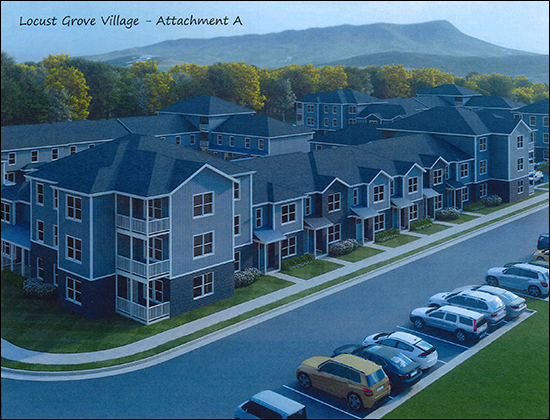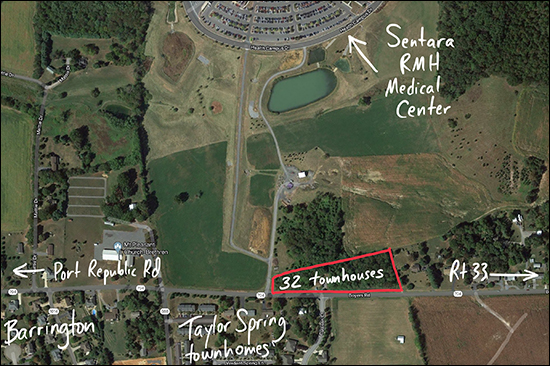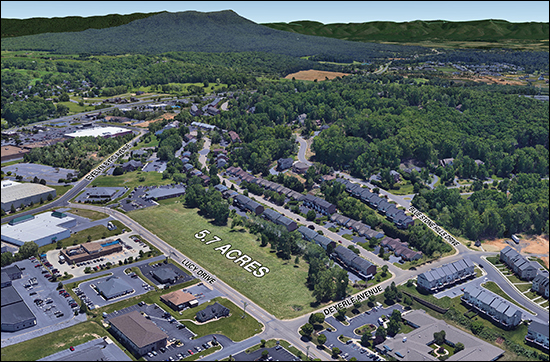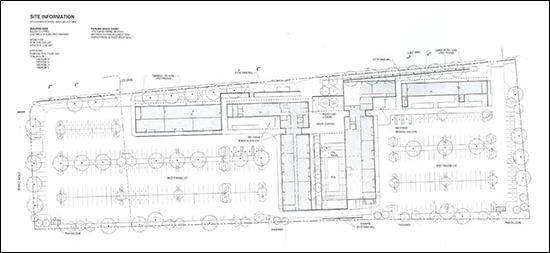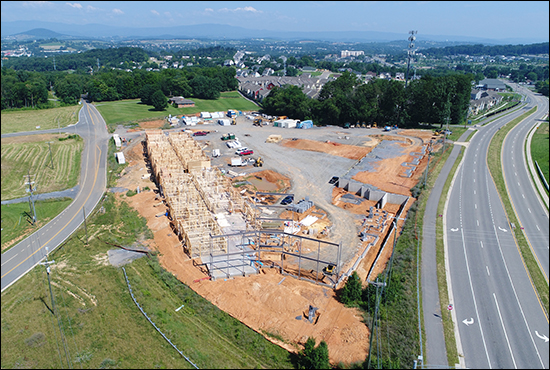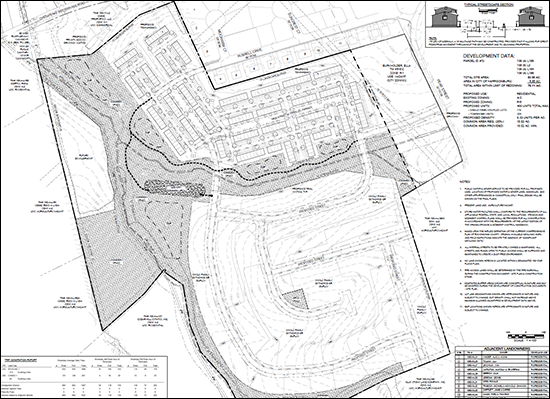| Newer Posts | Older Posts |
Rezoning Requested For 86 Condos on Boyers Road |
|
Randy Cosner (Cosner Investments, LLC) is requesting the rezoning of 5.9 acres of a 10 acre parcel on Boyers Road to allow for 86 condominiums to be built. The property is currently zoned A2, and the proposed zoning is Planned Multi-Family. This would allow for 86 condos with 1, 2 or 3 bedrooms, for a total of 186 bedrooms in four separate buildings surrounding common areas. The full rezoning request can be found here. Here's what the proposed site plan would look like... Per the rezoning application, the development would be called Locust Grove Village and would "provide a unique living opportunity for those inclined toward the beneficial aspects of community and socialization in a rural setting." Here is a rendering of what the buildings might look like... A few details from the developer's narrative include... "Specifically, Locust Grove Village will house no more than 86 individual condominiums containing a mixture of 1-, 2-, and 3-bedroom units. Units will be clustered into four buildings of 20-22 units apiece, with a majority of these units having a ‘townhouse' style and appearance. Building ‘corners' will be comprised of six condominium units served by a common entry and stairwell. Each pair of buildings will encircle a central green, with each townhouse-style condo having direct access through their own private courtyard. Half of the corner units will have balconies/courtyards that face the common green (interior), while the other half will face the exterior." "The central greens will be improved with tasteful landscaping (mixture of trees and shrubbery), paved walkways, a central gazebo, charcoal grills, and benches, intended to promote resident interaction and sense of community. If desired by residents, allowances will be made for community gardens, to be maintained by the residents themselves, and thereby promoting a sense of pride and ownership within the community. Pedestrian connectivity between the greens will be provided through walkways and a mid-block crosswalk through the parking area." "In sum, Locust Grove Village is intended to serve a growing desirability for attractive, communal living opportunities within a rural setting. Through emphasis of common areas and promotion of interaction between residents, Locust Grove Village will position itself as the premier condominium-based community within Rockingham County." The Rockingham County Planning Commission reviewed this rezoning request at their January 2019 meeting. Their main concerns, per the minutes, seemed to be:
The rezoning request was unanimously tabled at the Planning Commission meeting. We'll have to wait and see if the request will be reviewed and discussed again, but at this point these condos "might be" built -- because the rezoning has not yet been approved. | |
32 Townhouses To Be Built on Boyers Road |
|
Randy Cosner is planning to build 32 townhouses on 2.741 acres on Boyers Road as shown above. Below is the intended site layout, which includes common areas with a fenced tot lot playground and a picnic area with benches and a fire pit. The townhouses are to be built similar to the rendering below. Of note -- it is not clear whether these townhouses will be sold to individual buyers, sold to investors to then be rented, or retained by the builder to be rented. The townhouses pictured below are located on Leslie Court, located off of Vine Street, near its intersection with North Main Street. All 24 townhouses built on Leslie Court were purchased by investors (a total of perhaps four entities) and all 24 townhouses are now rented. 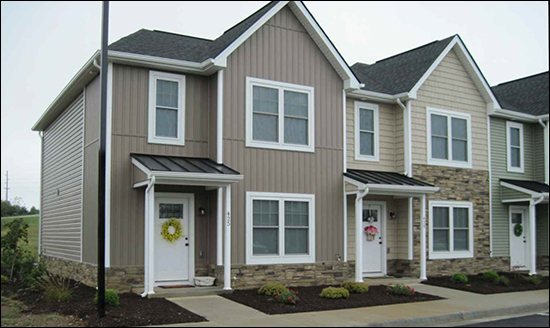 If you have driven by this location (Boyers Road) anytime recently you will have seen that all of the trees have cleared to prepare for construction. | |
The Latest on Possible Harrisonburg Short Term Rental Regulations |
|
 As reported in last week's Daily News Record, the City of Harrisonburg is continuing to discuss if they should try to better regulate short term rentals and if so, how. The lay of the land in Harrisonburg currently seems to be...
And so, the discussions continue -- and are likely to continue to continue -- as there does not seem to be a neat and tidy, balanced solution to this issue. Maybe there will be new regulations in 2019 that will allow or prohibit or limit or regulate short term rentals. Or, maybe, the zoning ordinance will remain the same, it will be illegal to rent all or part of your home out on a site like airbnb.com and some property owners will do it anyhow. | |
Harrisonburg City Council Considering Regulating Short Term Rentals |
|
 Do you have an opinion on whether short term rentals (such as via AirBNB) should be permitted and/or regulated in the City of Harrisonburg? If so, you should show up on Tuesday, September 11th for the public hearing on the topic. More from today's Daily News Record article...
| |
107 Apartments, Retail, Office Space Proposed on Lucy Drive |
|
The owners of two parcels on Lucy Drive are applying for a rezoning to allow for a mixed use development to be built on the corner of Lucy Drive and Deyerle Avenue. Here is the intended site plan... Here are some basic details, per today's Daily News Record article (see below) and from the rezoning application:
Read today's Daily News Record article about this potential development here. Review the full rezoning application packet to be reviewed by the Planning Commission on Wednesday here. The public hearing for this rezoning will take place on Wednesday, August 8th at 7:00 PM in City Council chambers. | |
College Student Housing Under Construction on Port Republic Road |
|
If you've driven on Port Republic Road lately, near Bojangles, you might have noticed construction starting to peek over the top of Port Republic Road. Above is an photo of the construction progress. And here are some images of the planned 425-bed college student housing community... | |
Can All Homes In Harrisonburg Be Rented To Groups of JMU Students? |
|
 With great regularity, potential buyers (either investors or parents of JMU students) will ask if a single family home can be purchased and rented to a group of JMU students -- often an intended group of four or more students.
I let them know that it will be no problem at all -- the adjoining property owners in the quaint neighborhood probably won't mind as long as the students aren't too bothersome -- and the City doesn't mind at all if their zoning ordinances are violated, so long as it's just "nice college kids".... WAIT! NOT REALLY! READ ON!!!! It seems that some buyers are really getting that feedback of "sure, it will be fine" -- though I'm not sure if they're getting it from their Realtor, or from someone else advising them in the transaction, or if they just aren't thinking about whether their planned use of a property is allowable. The REAL answer, and the feedback that I ACTUALLY provide to my clients is.... 1. We need to check to see how this property is zoned, and whether that zoning classification allows for that number of unrelated people to live in the property. 2. We need to check to see if there are recorded restrictive covenants for this neighborhood that restrict the number of unrelated people who live in the property. A few notes.... 1. Most single family homes in the City of Harrisonburg are zoned R-1 or R-2 and do NOT allow for three or more unrelated people (students or otherwise) to live in the property. 2. If a property has been used in a non-conforming manner (for example, four students living in it) since before the zoning ordinance was put in place, without a 24 month gap in the non-confirming us, it MIGHT be possible to continue to use the property in that non-conforming manner. And, if #2 above is starting to get confusing, then we arrive at my main reason for writing today.... CALL COMMUNITY DEVELOPMENT TO UNDERSTAND ALLOWED USE OF A PROPERTY! Yes, in fact, there are very helpful City staff in the Community Development department -- who can very quickly help you understand whether a property can be legally used as you intend to use it. And it is imperative that you make this call BEFORE you buy the property, and even BEFORE you make an offer on the property! | |
220 Detached Homes, 175 Duplexes, 225 Townhouses To Be Built in County? |
|
 Two rezoning proposals are going before the Rockingham County Planning Commission this week.... 54 Acres on Island Ford Road in McGahesyville (shown above)
Update after Planning Commission meeting.... Island Ford Road rezoning recommended by Planning Commission "In other business, the commission unanimously recommended approval of Gary Sandridge's request to rezone 54 acres on Island Ford Road in McGaheysville from agricultural use to planned single family. Sandridge plans to build 220 units that would connect to the existing Whispering Springs subdivision, which is at the intersection of Island Ford Road and McGaheysville Road." Pear Street rezoning tabled by Planning Commission "Commissioners Brent Trumbo, Rodney Burkholder and Keith Sheets voted to table the request. Commissioner Bill Loomis, who raised concerns over the density of the project and its compatibility with planned development in the city, abstained from voting. Commissioner David Rees was absent." Read more here.... County Planning Commission Tables Housing Request | |
Sunnyside Retirement Community Makes Plans For Newly Acquired Land |
|
 Back in 2015, Lakeview decided to sell off as much as 75 acres of their land, moving from a 36 hole golf course to a 27 hole golf course. Many (myself included) speculated that this land would be purchased by a developer or builder as the land is located in the midst of many upper end single family home neighborhoods. We were all wrong. Fifty acres (as shown above) were sold by Lakeview to Sunnyside Retirement Community in January 2017, for $1.2M. So, it seems, you will not see new roads going in and houses built in that area in the near future. But now we know a bit more what Sunnyside is planning for this newly acquired land. Sunnyside plans to add 28 acres of the newly acquired land to their master plan, to include:
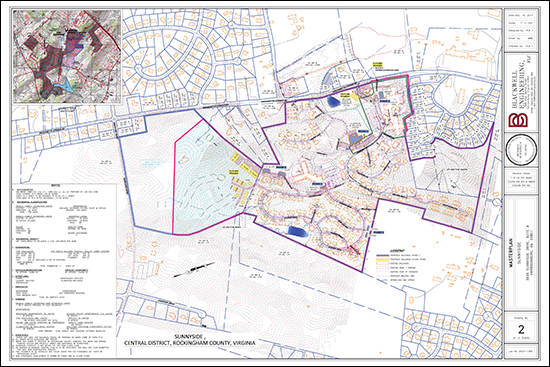 | |
How should land just outside Harrisonburg, in Rockingham County, be used in the future? |
|
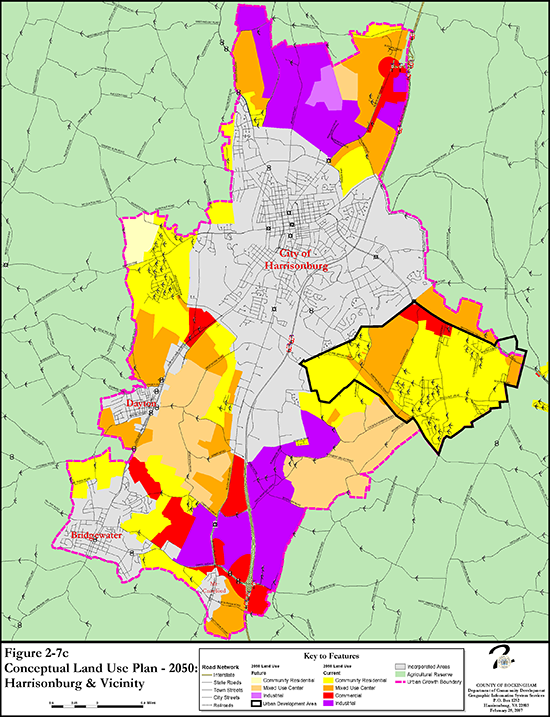 Just as there is a land use guide for the City of Harrisonburg, there is also a Conceptual Land Use Plan for many areas of Rockingham County. Above, I have included the Conceptual Land Use Plan for the areas just outside Harrisonburg (but in Rockingham County) for the year 2050. You can find many more maps -- showing different time frames, and different areas of the County -- on the County's comprehensive plan website. Of note, as you glance at the map above (or this PDF) you might note that the bright yellow regions are intended to be developed for residential use. It is not surprising that the largest contiguous section of such land is just East of the City, in what is referred to as the Urban Development Area. Industrial uses seem to largely be focused just North of the City and just South of the City. Enjoy exploring many more maps here. | |
How should land in Harrisonburg be used in the future? |
|
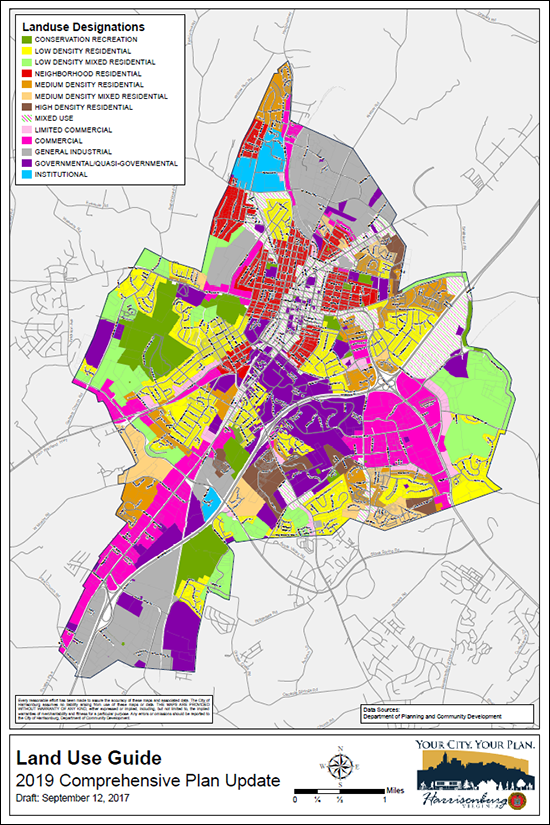 There's a map for that, it seems! Check out the Draft Comprehensive Plan (chapters) for the City of Harrisonburg where you'll find all sorts of interesting maps, including:
The Land Use Guide (draft for inclusion in the 2019 comprehensive plan is shown above) recommends future land uses, but is not regulatory. That is to say that if a piece of undeveloped land is zoned for residential use, but is shown in a "Mixed Use" area in the Land Use Guide map, then staff would likely look favorably upon a future request for rezoning to a mixed use designation. Check out all of the draft chapters of the Comprehensive Plan here. | |
Legality of Short Term Rentals in Harrisonburg, Rockingham County |
|
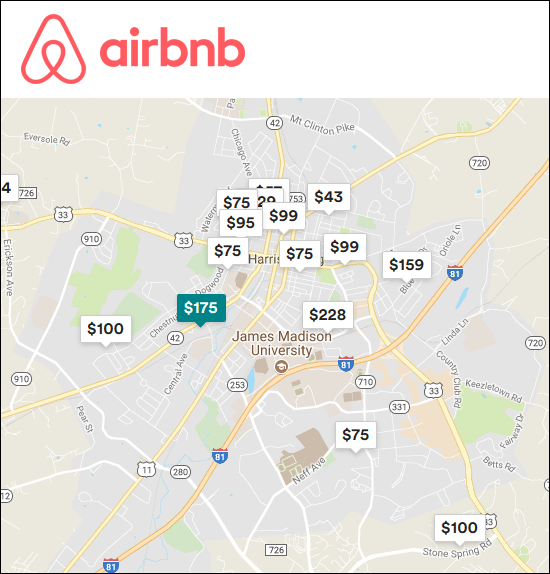 Stretching back a few weeks, Nolan Stout at the Daily News Record, wrote an informative article about short term rentals in this area. Bottom line -- and to answer a question many of my clients have asked me in recent years.... "The rentals, considered short-term rentals, are unregulated in Rockingham and illegal in Harrisonburg in residential zoning districts. That could change, however, as city and county officials consider taxing the property owners and creating zoning regulations to address neighbors' concerns." So, again....
A few other interesting snippets from the article....
Read the entire article here. | |
Can New Homes Be Built That Buyers Will Want and Can Afford? |
|
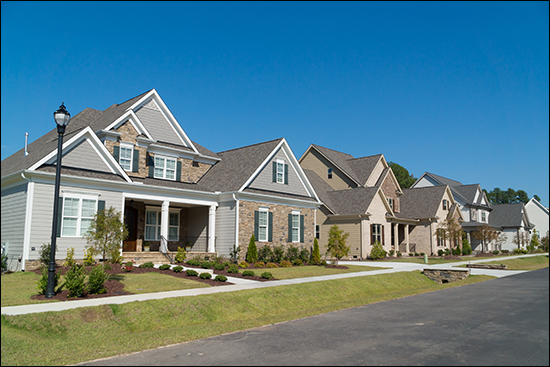 OK -- lots of great thoughts from folks over on Facebook yesterday, and in person as I talked to people around town yesterday, after I suggested that our market needs lots of mid size detached homes to be built. I'm going to think aloud about all of that by capturing a bit of that conversation here.... --- WHAT TYPES OF HOUSES? I had suggested that homes along these lines were needed for current townhouse owners that want to buy their first detached home....
These types of homes have not been built in large quantity over the past ten years, and I believe there are plenty of buyers who would love to buy this type/size of home. --- COSTS ARE HIGH BEFORE THE ACTUAL CONSTRUCTIONAs Jim, Jerry and Keith pointed out, It is expensive (!!!) to create a developed lot. The cost of building roads, installing water an sewer lines, utility hook up fees, etc. all add up to make the costs quite high even before construction (pouring the foundation, framing the home) begins. And as Nate points out -- if the land cannot be purchased by a builder at an affordable price, the rest of the equation downstream won't work out. High costs for land, plus development costs, plus building costs, will result in unrealistically high prices for homes, that then won't be affordable (or desirable at that price point) to buyers. Nate then ponders whether larger, regional builders can do better than local builders in this regard based on economies of scale. I'm not sure if the savings would be in buying a larger tract of land, lower development (infrastructure costs), or lower building costs -- but I wonder the same. Gary and Renee also point out that some of these "costs before you even start building" are high because of utility connection fees, requirements for stormwater management, proffers, etc., that are coming from government regulations and development requirements. Ginny points out that the final cost of a house is largely dependent on the initial land and development costs. Thus, to have smaller single family homes built, we may need to see smaller lots, to keep those initial costs down. --- DEMAND NEEDS TO DISCUSSED WITHIN THE CONTEXT OF PRICE As Jim succinctly puts it, "If I want something I can't afford then it isn't really demand." An excellent point -- which means that we need to think about (and talk about) the demand for the homes I outlined above (for example) within the context of the price for bringing such a home to market. If the houses I described (1750 / 1950 / 2150 square feet) were able to be sold for $150K, $175K and $200K (obviously not realistic) then clearly, there would be a ridiculously high demand for them. I believe that if the houses I described could be sold for $250K, $275K and $300K there would still be a strong demand for them. But, clearly, if the homes could not be sold for any less than (I'm exaggerating again) $400K, $425K and $450K then likely NOBODY would want want to buy them. So, yes, when we talk about demand for a particular type of housing, it likely should be -- as best as possible -- set within a context of price. That price-based demand can then be compared to development and building costs to see if developer and builders can bring such a product to market at a price that it will sell. --- WHAT SHOULD WE BE ADDING TO OUR HOUSING STOCK? As Jim also points out, the high demand and low supply environment we're in right now COULD cause a large quantity of under-qualified builders to start building homes. This doesn't help, in the long-term, as it is adding lower quality homes to our housing stock, which I do not believe helps our community in the long-term. Jim goes on to suggest that we should be ensuring that we are adding quality homes to our housing stock. I agree -- though I do think that we need to find a balance. If the quality of materials and finishes is too high, we're pricing ourselves out of the ability to meet the demand we're discussing. Michael takes us in a different direction when considering what should be built. He points out that even beyond building for all of those townhouse buyers (the original reason for my suggestion that we need to build mid sized detached homes) that he believes there is also a significant demand for affordable housing for the elderly in our community. He points out that retirement communities are not affordable for everyone, and plenty of older adults in our community would love to move into an affordable, (one-level), wheelchair accessible home. Again -- another market segment where we are not seeing much new construction. --- WHAT ARE PEOPLE GOING TO DO IF WE DON'T BUILD THESE HOMES? Ginny suggests that homeownership may be delayed for some families. A good point -- if the homes they want aren't available at the prices they can afford, perhaps they'll keep renting or keep living in the townhome they purchased. Ginny also suggests that we'll see more remodeling or upgrading of current homes to accommodate growing families, which also makes sense. Keith suggests that people will just have to move to some of the more affordable towns surrounding Harrisonburg. There are more affordable detached housing options when you look to Broadway, Timberville, Elkton and Grottoes. So, perhaps the townhome owners will just have to settle for a bit of a commute in order to buy a mid sized detached home that fits their budget. Jim suggests that maybe higher costs for new homes means that it will take much longer for families to be able to buy a home -- and perhaps they will have to stay in one home for a lifetime, instead of moving every 5 - 7 years. Gary concludes that many in our community may simply have to rent, or keep living in a townhouse, because of the cost of building new homes. --- CONCLUSIONS There were many other great points made, and discussions beginning, so thanks to all who engaged in this topic. A few big picture thoughts that come to mind for me....
Keep the conversations going, folks, on Facebook, with me, with each other. As Jim points out, "we're going to have to do housing differently than it has been built in the past 30 years if we are going to provide sustainable, affordable housing." | |
What is being developed at the corner of Stone Spring Road and Spotswood Trail? |
|
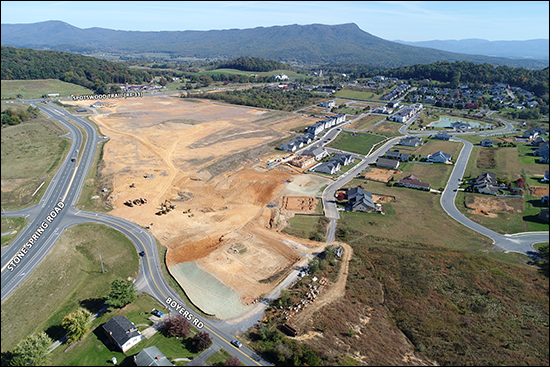 download a larger version of this photo here Just driving by, you might not realize the extent of the mass grading that is currently underway on the corner of Stone Spring Road and Spotswood Trail. The photo above should put it into perspective. This is a LOT of land that is being leveled and prepared for development. But for what, you might ask? A good chunk of it will be used for apartments, it seems -- and the balance for future commercial development. Below is my understanding of the intended use of the space.... 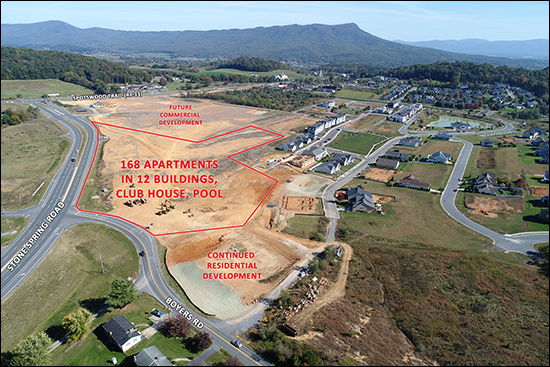 download a larger version of this photo here My understanding of this intended usage of this land is based on the Preston Lake master plan as shown below, updated as of December 2016.... 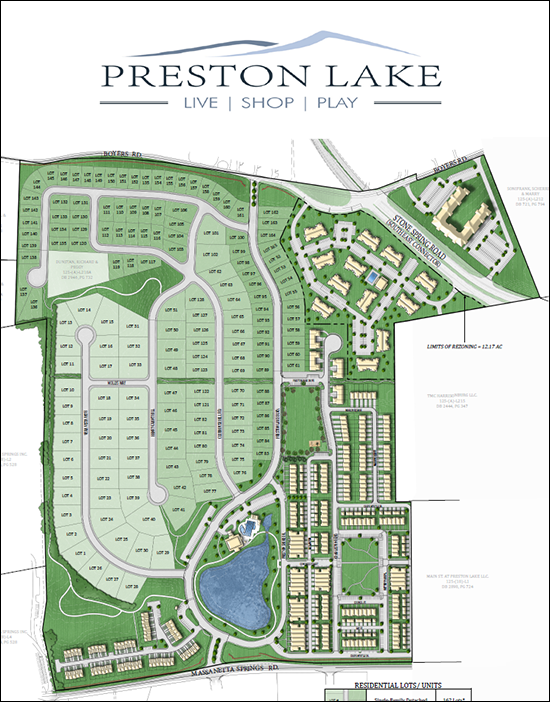 The area that is currently being graded will include the area shown below surrounded by a dashed line. This will include 168 apartments in 12 buildings, as well as a clubhouse and pool. 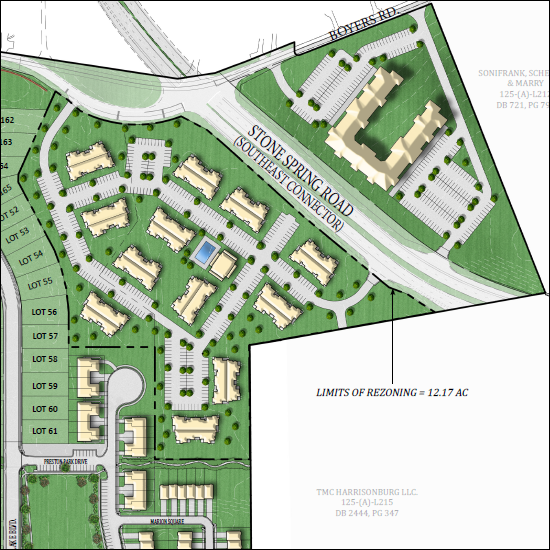 Part of the land being graded in the aerial photo at the top of this post is intended to be used for future commercial development. So, who owns all of this land?
As it pertains to the 168 apartments.... "State Corporation Commission records list William Park of Charlottesville as the registered agent for Mid Town Square. Park is co-owner of Park Properties Management and president of Pinnacle Construction & Development Corp., which builds the apartments."The article went further to identify other complexes in this region that are owned and managed by Park's companies.... "Park's companies are behind two complexes in the area.Digging even further into my archives, I am finding that in the original packet for the proposed approval of the updated Preston Lake master plan (now approved) the engineer for the Preston Lake developer indicated that the apartment buildings are intended to be 2-stories in height. There are also quite a few additional details in that development packet as it pertains to proffers made by the developer when this updated master plan was approved. | |
Make your voice heard in the updated Comprehensive Plan for the City of Harrisonburg |
|
 The City of Harrisonburg is in the midst of updating the Comprehensive Plan for the City. As per the City.... The Comprehensive Plan presents a vision of Harrisonburg's future. It identifies steps to move toward that vision by providing information about current conditions, long-term goals and objectives, and recommended implementation strategies. As described in the Code of Virginia, the Comprehensive Plan is general in nature. Harrisonburg's Plan addresses a wide range of issues including but not limited to: land use, housing, education, transportation, recreation, the preservation of historic and natural resources, and economic development. The plan serves as a long-term guide for the community, and it helps City leaders with setting policies and decision-making. So, basically, what do you want the City of Harrisonburg to be in 10 or 20 years? Discussions taking place and decisions being made right now will affect that future, and you have the opportunity to be a part of the conversation! Better yet -- there are several Public Workshops coming up that will allow you to chime in on topics near and dear to your heart.... Education; Arts, Culture, and Historic Resources; and Community Engagement & CollaborationSo, mark your calendars, and get involved in the discussions and decisions to help shape the future our our great City! Also of note.... Lots of Q&A's about the Comprehensive Plan update can be found here. General information about the Comprehensive Plan update can be found here. | |
Price Distribution of Single Family Housing Stock in the City of Harrisonburg |
|
 OK -- Take 2 -- Based on some feedback, in smaller price increments this time.... Forget about what actually SELLS in any given timeframe, or even what is available FOR SALE at any given point in time. Let's get down to what housing actually EXISTS in the City of Harrisonburg. The graph above shows the number of single family detached homes (Use Code 006 in the City's property database) that exist in the City of Harrisonburg in (120 different price ranges. The homes are sorted into these price categories based on their 2017 assessed values. So -- what surprises you? If more single family homes are to be built in the City, what price range should they fit into? | |
Harrisonburg could never have enough student housing! |
|
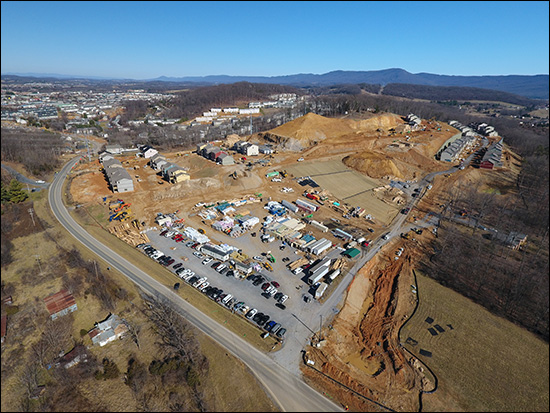 OK, OK, that's probably not true -- Harrisonburg probably does not have an infinite need for student housing. Just consider my title, then, to be an intro to all of the alternative perspectives that have been shared with me since I wrote these two posts.... Does Harrisonburg need more Off Campus Student Housing? Does New College Student Housing Increase the Demands on Local Elementary Schools? OK -- here goes -- all the reasons I might be wrong, and all of this new student housing might be OK, or even a good thing.... 1. JMU is growing! All of this student housing is necessary -- JMU is continuing to grow, and they are not building on campus fast enough for their growth, so the private sector must build and rent housing to students in order to meet that growing demand. 2. Denying growth just pushes it elsewhere. If the City decided to stop permitting new student housing communities to be built, that would just push developers to build them in the County, or push students to live in otherwise owner occupied neighborhoods. 3. This is an affordable way to get workforce housing. There isn't much truly affordable rental housing being built -- and older student housing complexes being effectively turned into workforce housing by virtue of students being attracted to new student housing communities is not necessarily a bad thing. It may be the most affordable way to create affordable or workforce housing. 4. Bring on the wrecking ball. If even more student housing is built, the rental rates will fall even lower on the oldest complexes, devaluing those properties to the point where it will make sense to just knock them down and build new housing -- thus, eliminating the older, outdated housing. 5. How much regulation do you want "the government" to do? If the government (planning commission, city council, staff) should start making judgement calls about how much student housing is too much student -- and thus regulating what landowners (and student housing developers) can and cannot do -- should they also start governing other segments of the private sector? Should they regulate how many hair salons exist? How many banks are permitted to operate? How many restaurants can open? How many Realtors can sell homes? :) OK -- again -- I don't necessarily agree with all of the perspectives above, but I believe it is important to consider these counterpoints when thinking about how our community should be planning for the future as it pertains to student housing, land use, property taxes, schools, etc. And, as I mentioned to a reader in response to their comments.... I don't know if new student housing projects should or should not be denied - but I think the local community needs to fully understand the impact of continuing to approve more student housing communities. If older student housing communities become workforce housing, great, no problem -- but let's realize that this is the result of approving new student housing communities, and make sure that infrastructure (schools, for example) are in place for the new workforce housing that we have indirectly created. | |
Does New College Student Housing Increase the Demands on Local Elementary Schools? |
|
 Traditional logic would say no -- the construction of new college student housing in Harrisonburg won't increase the load on elementary schools, as most college students do not have elementary school aged children.... Going a step further, I would guess that some local government staff and elected officials MIGHT (?) use this traditional logic when thinking about whether to approve rezonings, or other approvals, for new student housing to be built in the Harrisonburg area. But wait - what if the following sequence happens (thanks Deb, with some revisions)....
I think we have seen this happen over the past 20 years in Harrisonburg, in cycles, as large quantities of student housing is built in waves. And think about it, from the other direction, for a moment -- we all know that the local elementary school population is growing -- but why, and where? It's not as if local developers and builders are out building an extraordinary number of townhomes or starter homes for young families, causing an influx of new elementary school students. So -- if the elementary school population is rising, and it's not because of an increase in the stock of owner occupied real estate in Harrisonburg, then.... 1. Perhaps this elementary (or K-12, really) school enrollment growth is, contrary to what we'd otherwise believe, a direct result of an increase in college student housing. 2. Perhaps we need to think about the fiscal impact of educating more elementary (and then middle and high) school students when we think about approving yet another student housing complex. 3. Perhaps, if building new student housing when we might not really need it, leads to increased demands on our local K-12 schools, then maybe we need to pay more attention to whether that student housing is needed. Just some thoughts to ponder as we think about and plan for the future here in the City of Harrisonburg -- and Rockingham County. | |
Does Harrisonburg need more Off Campus Student Housing? |
|
 Altitude at Stoneport will soon be built on Port Republic Road, with room for 425 students. The Retreat is nearing completion on Reservoir Street, with room for 700 students. JMU enrollment is growing, but only by about 350 students per year. And now, a 22 unit apartment building is proposed for the edge of the Purcell Park neighborhood -- which is and is not applicable to the matter at hand.... So, here's the deal.... 1. A local resident (developer) is intending to replace two older single-family homes with a mixed-use complex with restaurants, retail space and (22) one-bedroom apartments. STAFF recommends approving it. PLANNING COMMISSION does not. CITY COUNCIL might, or might not approve it. Read more here: Planners Discuss Decision. 2. Many neighbors of the proposed development are opposed to this potential development - because it would increase traffic, change the nature of the neighborhood, increase the population density in that area, and because some believe it will just be filled up with college students. 3. A JMU official (coordinator of off-campus life) wrote a letter on JMU letterhead to City Council and residents of the neighborhood indicating that JMU has no need for more off-campus housing. Read the entire DNR article here (JMU: Official's Letter On Zoning Issue Not Official) or an excerpt of the LETTER here.... "Additional apartment-based housing is not needed at this point in the community, and might actually be detrimental to current properties who are having difficulty reaching capacity with tenants and profiting," 4. The developer's engineer indicates that the apartments are not designed for college students. OK -- so -- let's sidestep the issues of the aforementioned letter not really being JMU's official position on the matter AND whether or not the apartments are or are not intended for or suited for college students. Instead, let's think about (talk about?) whether Harrisonburg needs more off campus student housing. So -- do we need more? Most student housing developers coming to the area would say that we do -- but they might always say that? After all, the newest and nicest student housing (almost) always leases quickly. In contrast, I would argue that all income college students (for 2018-19) could easily fit into existing on and off campus housing, even without the addition of The Retreat or Altitude. So, why do these new complexes keep showing up? Because the newest and nicest complexes always lease quickly. And because a student housing developer can make money by building such a development in this area. And because the City and/or County continues to approve these developments -- perhaps not feeling it is their place to decide whether there is a need for more housing. Side note -- should City/Council decision making bodies approve or disapprove student housing based on whether there is a need for more? I do not recall any instances when this is a question that these governing bodies discuss -- they seem to assume that the developer wouldn't be proposing it unless it were needed (which is not necessarily true -- see above) and then just move on to whether it is reasonable to develop the proposed land in the proposed manner. So, if student housing developers will always want to build more, and local decision makers might keep approving the developments independent of whether there is a need or not, I might just be wasting my time to continue to think about all of this -- but I'll continue nonetheless. I think we (citizens, tax payers, elected officials) need to realize what happens when more student housing is approved when there is not necessarily an actual need for more such housing. And the place to look to best understand this is the oldest student housing. What typically happens when new student housing is built is that the oldest (and/or least conveniently located and/or least upgraded) student housing eventually starts having higher occupancy rates, and then eventually starts being leased to folks who are not college students. All of that is well and fine and good -- except that it means that the rental income often declines, the properties aren't maintained as well, vacancy rates climb higher, rental income drops lower, property maintenance declines further, etc. So -- we end up having (or will end up having) older apartment complexes that used to be college student housing -- that are now rented to non-students -- often to low income individuals and families -- and that are often not maintained as well as when the rental income allowed for them to be better maintained. Is this (college housing potentially becoming low income housing) a bad thing? Not necessarily -- but I think that we need to realize that this is often the eventual, market driven, impact of continuing to approve new student housing developments. Are we comfortable with this long term end to our short term decisions? Is this the way that we want to grow our housing stock? Hopefully I have provided MANY more questions than answers. :) Feel free to drop me a line to discuss, or offer your opinions and perspectives. | |
Can this house be rented to a large group of college students? |
|
 With great regularity, potential buyers (either investors or parents of JMU students) will ask if a single family home can be purchased and rented to a group of JMU students -- often an intended group of four or more students. I let them know that it will be no problem at all -- the adjoining property owners in the quaint neighborhood probably won't mind as long as the students aren't too bothersome -- and the City doesn't mind at all if their zoning ordinances are violated, so long as it's just "nice college kids".... WAIT! NOT REALLY! READ ON!!!! It seems that some buyers are really getting that feedback of "sure, it will be fine" -- though I'm not sure if they're getting it from their Realtor, or from someone else advising them in the transaction, or if they just aren't thinking about whether their planned use of a property is allowable. The REAL answer, and the feedback that I ACTUALLY provide to my clients is.... 1. We need to check to see how this property is zoned, and whether that zoning classification allows for that number of unrelated people to live in the property. 2. We need to check to see if there are recorded restrictive covenants for this neighborhood that restrict the number of unrelated people who live in the property. A few notes.... 1. Most single family homes in the City of Harrisonburg are zoned R-1 or R-2 and do NOT allow for three or more unrelated people (students or otherwise) to live in the property. 2. If a property has been used in a non-conforming manner (for example, four students living in it) since before the zoning ordinance was put in place, without a 24 month gap in the non-confirming us, it MIGHT be possible to continue to use the property in that non-conforming manner. And, if #2 above is starting to get confusing, then we arrive at my main reason for writing today.... CALL COMMUNITY DEVELOPMENT TO UNDERSTAND ALLOWED USE OF A PROPERTY! Yes, in fact, there are very helpful City staff in the Community Development department -- who can very quickly help you understand whether a property can be legally used as you intend to use it. And it is imperative that you make this call BEFORE you buy the property, and even BEFORE you make an offer on the property! | |
| Newer Posts | Older Posts |
Scott Rogers
Funkhouser Real
Estate Group
540-578-0102
scott@funkhousergroup.com
Licensed in the
Commonwealth of Virginia
Home Search
Housing Market Report
Harrisonburg Townhouses
Walk Through This Home
Investment Properties
Harrisonburg Foreclosures
Property Transfers
New Listings

